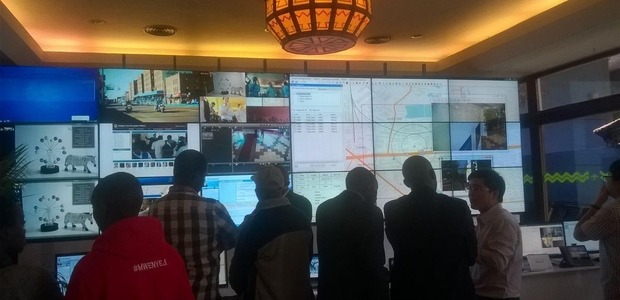advertisement
Huawei’s Safe City Summit kicks off in Kenya
Huawei hosted its Safe City Africa Summit & Kenya Showcase 2016 in Nairobi, Kenya from October 14-15, 2016. Entitled “Leading…

Huawei hosted its Safe City Africa Summit & Kenya Showcase 2016 in Nairobi, Kenya from October 14-15, 2016. Entitled “Leading New ICT, Making Cities Safer”, the Summit showcased Safe City best practices in cities like Nairobi and Mombasa, and gave attendees the latest insights on industry trends and opportunities in the new ICT era.
As part of its strategy of industry collaboration to drive innovative Safe City solutions, Huawei alsodemonstrated its new 4G and cloud-based smart Safe City solution, co-developed with partners, and shared other partner innovations successfully deployed in Africa.
Recognized as the heart of Africa, Kenya is the continent’s economic and tourism hub and the government of Kenya has embraced Safe City solutions as a national strategy to maintain this position. Huawei teamed up with Safaricom to implement the first phase of Kenya’s Safe City project with new ICT,covering the most densely populated cities of Nairobi and Mombasa. Following the completion of the project, these cities have improved their local security and according to the Kenya Police annual report, crime rates from 2014 to 2015 decreased by 46% in areas covered by the Safe City project.
advertisement
Ms. Diana Yuan, President of Marketing & Solution Sales Dept of Huawei Enterprise Business Group(BG), said in her speech at the Summit, “Public safety is gradually becoming a necessity to raise living standards for everyone. The Summit today is of special significance. You can personally experience practical applications of Safe City solutions. Adhering to the principle of customer centricity, Huawei cooperates with partners and customers to build smarter, safer, and better connected Safe Cities with our new ICT infrastructure featuring Cloud-Pipe-Device integration. Huawei’s Safe City solutions will comprehensively improve city management and contribute to city safety and prosperity in African countries.”
Safe City in the New ICT Era
Mr. Kamal Naim ,Head of ICT, UN-Habitat (United Nations Human Settlement Programme),stated in his keynote speech that a safer city is grounded on three main pillars of prevention that embrace a holistic,as Law enforcement and CJS reform、Social Prevention、Urban Design, integrated and multi-sectorial approach to improving the liveability of cities and quality of life for all urban residents, predicated on the confidence that good urban governance, planning and management can improve the neighborhoods’ safety.
advertisement
In his keynote speech titled “Safe Cities: Driven by a Technology Revolution”,Mr.Thomas Lynch, Director of Critical Communications for IHS Markit, shared insights into how public safety is a comprehensive system where traditional video surveillance, voice dispatching, Computer-Aided Dispatch (CAD), Geographic Information System (GIS), and call-taking and dispatching systems are closely integrated to enable threat awareness, early warning, and incident management throughout the whole process. According to the latest research from IHS Markit, the market scale of public safety equipment is estimated to increase from USD13 billion in 2015 to USD20 billion in 2020.
Mr. Hong-Eng Koh, Huawei’s Global Chief Public Safety Expert, said in his keynote speech that while intelligent video surveillance, broadband trunked radio and computer aided dispatch are crucial, they are not enough to create a Safe City. There is a need for policing cloud to link up the silos of different public safety agencies for better information sharing and user experience. With the exponential growth of data from traditional policing records, video surveillance, social networks and the Internet of Things, Big Data analytics are important too. Together these technologies can help in threats prevention, and if not preventable, early detection for faster response and recovery; with the aim of reducing loss of life and property, and bringing justice and normalcy to society.
Huawei Cooperates with Partners to Build a New Ecosystem
advertisement
At the Summit, Huawei displayed its new smart Safe City solution, co-developed by Huawei and its partners . The solution consists of the world’s first visualized and converged command system, the industry’s first 4G professional trunking system, world-leading cross-region and cross-agency video cloud, and business-driven Safe City ICT infrastructure.
Additionally, Safaricom, the largest comprehensive telecommunications service provider of Kenya, shared its cooperation with Huawei in the development of the Kenya Safe City project. According to a speech from Shaka Kwach, who is the Head of Special Projects department form Safaricom Limited, the deployments of Huawei’s Safe City solution in Nairobi and Mombasa has drastically improved criminal investigation, cross-agency collaboration, and emergency response efficiency for the National Police Service. This has resulted in tangible benefits to both the citizens of Kenya, as well as the officers using the solution.
Today, Huawei has worked with more than 100 partners, over 550 certified service partners, and beyond 120 authorized service partners in the ICT field all over the globe, forming the framework of a new Safe City ecosystem. The new Safe City ecosystem consists of consulting firms (BGS and Accenture), system integrators (Safaricom and Tyco), and software vendors (Hexagon, Milestone, SAP, iOmniscient, Promad, and AgentVi).
In the Safe City industry, Huawei has launched end-to-end Safe City solutions with its partners, serving 400 million people across more than 100 cities of over 30 countries. Moving forward, Huawei will continue to cooperate with its partners to develop open、combined and smart Safe City solutions tailored to customer needs.